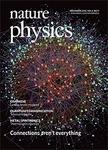版权所有:内蒙古大学图书馆 技术提供:维普资讯• 智图
内蒙古自治区呼和浩特市赛罕区大学西街235号 邮编: 010021

作者机构:Department of Physics and Astronomy University of California Riverside CA USA Department of Physics Ohio State University Columbus OH USA Department of Physics Ohio State University Columbus OH USA Department of Physics and Astronomy University of California Riverside CA USA National High Magnetic Field Laboratory Tallahassee FL USA National Institute for Materials Science Tsukuba Japan Department of Electrical and Computer Engineering University of California Riverside CA USA Department of Physics and Astronomy University of California Riverside CA USA Department of Electrical and Computer Engineering University of California Riverside CA USA Department of Physics University of Texas at Austin Austin TX USA
出 版 物:《NATURE PHYSICS》 (自然物理学)
年 卷 期:2018年第14卷第9期
页 面:967-967页
核心收录:
基 金:We thank H. Chen for helpful discussions. The work is supported by SHINES which is an Energy Frontier Research Center funded by the Department of Energy (DOE) Basic Energy Sciences (BES) under Award #SC0012670. S.C. is supported by DOE BES under award ER 46940-DE-SC0010597 to study the quantum Hall effect in graphene. A.H.M. acknowledges partial support by the Welch Foundation under grant TBF1473. Part of this work was performed at the NHMFL which is supported by NSF/DMR-0654118 the State of Florida and the DOE. Growth of hBN crystals was supported by the Elemental Strategy Initiative conducted by the MEXT Japan and a Grant-in-Aid for Scientific Research on Innovative Areas ‘Science of Atomic Layers’ from the Japan Society for the Promotion of Science (JSPS)
主 题:Quantum Hall Spintronics Two-dimensional materials
摘 要:Because of their ultrafast intrinsic dynamics and robustness against stray fields, antiferromagnetic insulators1–3 are promising candidates for spintronic components. Therefore, long-distance, low-dissipation spin transport and electrical manipulation of antiferromagnetic order are key research goals in antiferromagnetic spintronics. Here, we report experimental evidence of robust spin transport through an antiferromagnetic insulator, in our case the gate-controlled state that appears in charge-neutral graphene in a magnetic field4–6. Utilizing quantum Hall edge states as spin-dependent injectors and detectors, we observe large, non-local electrical signals across charge-neutral channels that are up to 5 μm long. The dependence of the signal on magnetic field, temperature and filling factor is consistent with spin superfluidity1,2,4,7–10 as the spin-transport mechanism. This work demonstrates the utility of graphene in the quantum Hall regime as a powerful model system for fundamental studies in antiferromagnetic spintronics.